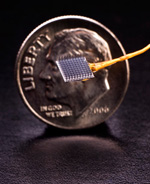A new study, published in the May17 issue of Nature, reports that in an ongoing clinical trial, two people with tetraplegia were able to reach for and grasp objects in 3D space using robotic arms that they controlled directly with brain activity. They used the BrainGate brain-computer interface (BCI) system, initially developed by Brown University, Providence, Rhode Island, which is currently being studied under an Investigational Device Exemption.

BrainGate uses a 4×4 mm silicon electrode array to read neural signals directly within brain tissue. Photograph courtesy of BrainGate Collaboration.
The BrainGate2 pilot clinical trial uses the BrainGate system, a 4x4mm device with a grid of 96 tiny electrodes, which is implanted in the motor cortex. The electrodes are close enough to individual neurons to record the neural activity associated with intended movement. An external computer translates the pattern of impulses across a population of neurons into commands to operate assistive devices, such as the two robotic arms used in the study-one developed by the German Aerospace Center (DLR) Institute of Robotics and Mechatronics, Cologne, and the other by DEKA Research and Development, Manchester, New Hampshire.
A 58-year-old woman (S3) and a 66-year-old man (T2) participated in the study. They had each been paralyzed by a brainstem stroke years earlier that left them with no functional control of their limbs and unable to speak.
In one task, several foam targets were mounted on levers on a tabletop and programmed to pop up one at a time, at different positions and heights. The participants had less than 30 seconds to grasp each target using the DEKA Arm System (Generation 2). T2 was able to grasp the targets 62 percent of the time, and S3 had a 46 percent success rate.
S3 also used the BCI-robotic arm system to serve herself coffee for the first time since becoming paralyzed and unable to speak nearly 15 years ago. She controlled a robotic arm by thinking about moving her arm and hand to lift a bottle of coffee to her mouth, issue a command to tip it, drink through a straw, and return the bottle to the table. That achievement is one of the advances in BCIs, restorative neurotechnology, and assistive robot technology described in the study by the BrainGate2 collaboration of researchers at the Department of Veterans Affairs (VA); Brown; Massachusetts General Hospital (MGH), Boston; Harvard Medical School, Boston; and DLR.
BrainGate participants have previously demonstrated neurally based, two-dimensional point-and-click control of a cursor on a computer screen and rudimentary control of simple robotic devices.
This study represents the first demonstration and the first peer-reviewed report of people with tetraplegia using brain signals to control a robotic arm in 3D space to complete a task usually performed by their arm.
“Our goal in this research is to develop technology that will restore independence and mobility for people with paralysis or limb loss,” said lead author Leigh Hochberg, MD, PhD, a neuroengineer and critical care neurologist who holds appointments at the VA, Brown, MG, and Harvard. He is the sponsor-investigator for the BrainGate2 pilot clinical trial. “We have much more work to do, but the encouraging progress of this research is demonstrated not only in the reach-and-grasp data, but even more so in S3’s smile when she served herself coffee of her own volition for the first time in almost 15 years.”
Hochberg added that even after nearly 15 years, a part of the brain essentially “disconnected” from its original target by a brainstem stroke was still able to direct the complex, multidimensional movement of an external robotic limb. The researchers also noted that S3 was able to perform the tasks more than five years after the investigational BrainGate electrode array was implanted. This sets a new benchmark for how long implanted BCI electrodes have remained viable and provided useful command signals.
However, Hochberg noted that the technology is years away from practical use and that the trial participants used the BrainGate system under controlled conditions in their homes with a technician present to perform a calibration procedure that lasted 31 minutes on average.
As the trial continues, the BrainGate research team needs to test the technology in more individuals, they said. They envision a system that would be stable for decades, wireless, and fully automated. For now, the sensor-and therefore the user-must be connected via cables to the rest of the system. Improvements are also needed to enhance the precision and speed of control. In the foam target task, for example, a successful reach-and-grasp motion typically took almost ten seconds.
The ultimate goal for helping people with paralysis is to reconnect the brain directly to paralyzed limbs rather than robotic ones, the researchers said. In the future, the BrainGate system might be used to control a functional electrical stimulation (FES) device, which delivers electrical stimulation to paralyzed muscles. Such technology has shown promise in monkeys.




